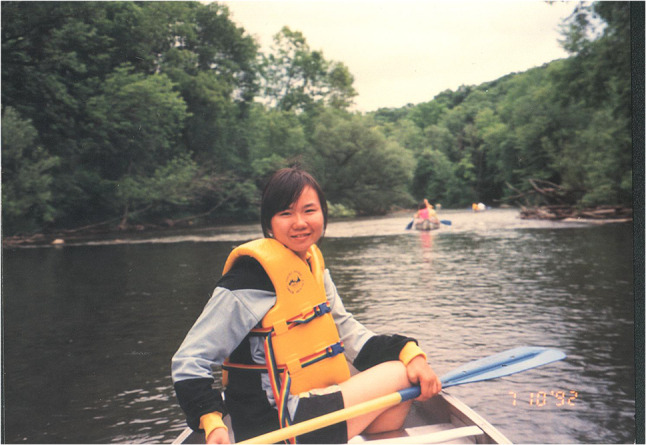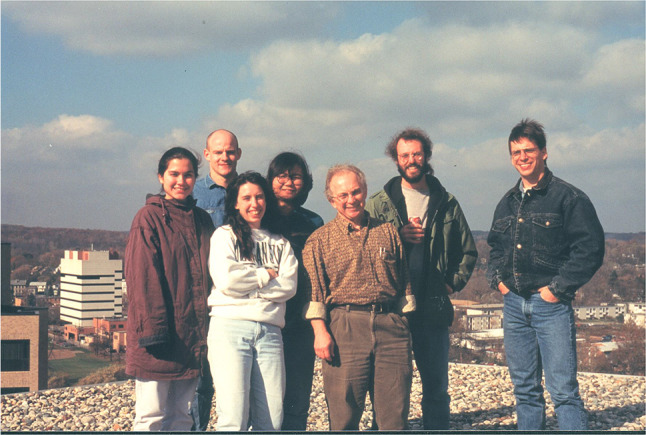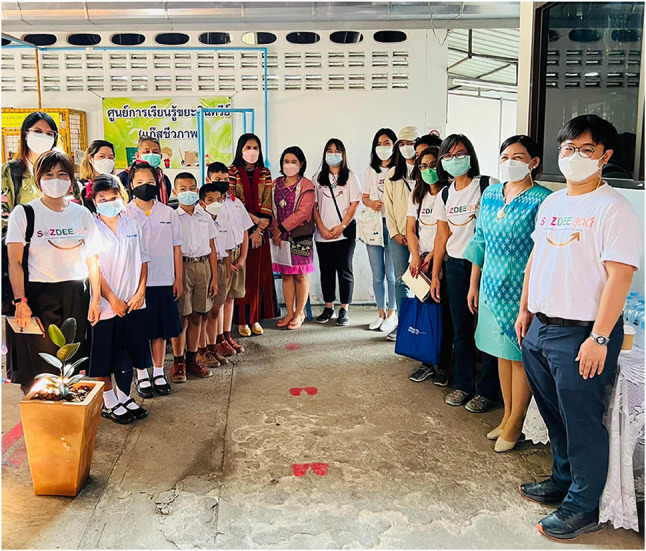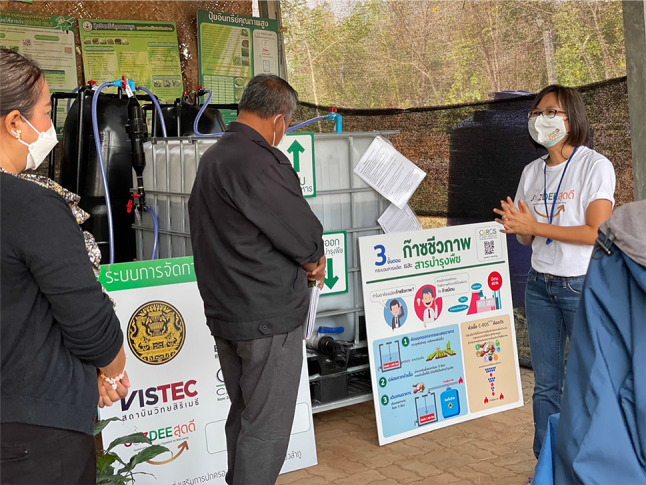Abstract
Pimchai Chaiyen is a professor of School of Biomolecular Science and Engineering (BSE) at Vidyasirimedhi Institute of Science and Technology (VISTEC). She is among the most accomplished scientists in Thailand and in her research fields globally. Dr. Chaiyen trained as a mechanistic enzymologist at University of Michigan, Ann Arbor, under the guidance of David P. Ballou and the late Vincent Massey. She was an independent investigator at Mahidol University from 1997 to 2017. She then moved to VISTEC as founding dean of the BSE school. Dr. Chaiyen works on the broad areas of enzyme catalysis, enzyme engineering, systems biocatalysis, metabolic engineering, and synthetic biology. Her group investigates mechanisms of enzymatic reactions and metabolic pathways, and explores innovative applications of enzymes and metabolically engineered cells. Her team also works with local communities and the private sector to implement technologies promoting sustainability and circular economy. Dr. Chaiyen was a speaker at the Women in Science symposium at 20th IUPAB congress, 45th Annual SBBF meeting and 50th Annual SBBq meeting (held virtually in Brazil).
Early education
I was born in Phuket, Thailand (Fig. 1). My hometown is among the world’s top tourist destinations for its beautiful beaches. When I was growing up, there was no obvious inspiration to motivate me to become a scientist. I had not encountered anyone in Phuket who actually made a living from being a scientist or a researcher. I learned about scientists only from a book of simplified stories of world-renowned scientists, of whom none was Thai. Although I quite enjoyed studying science and mathematics back then, I doubted if there was any real career path in these.
Fig. 1.

Pimchai Chaiyen (right) and her younger sister (Naiyanet Chaiyen, M.D. (cardiologist)) in front of their old house in Phuket where they grew up
Two years before I finished primary high school, the Thai government had launched a special scholarship named Development and Promotion of Science and Technology Talent project (DPST). It provided support for young students to pursue science studies from secondary high school through to PhD level. In return, the recipients undertook a bond to work in Thailand’s academic sector after completing their studies.
Training in Thailand
The DPST project aimed to distribute their scholars’ education locations throughout all regions of Thailand. As such, I had to move out from my hometown to study in Hatyai (Songkla) for high school and Bachelor’s degree at Prince of Songkla University. The scholarship also arranged for a science camp in Bangkok every summer where we got to network and had a chance to learn about science and technology developments in Thailand. After all, most of the major academic, science and technology activities in Thailand were concentrated in Bangkok.
It was in the summer of 1987 that I found my calling and got interested in biochemistry. I was on a 2-week attachment in Prof. Prapon Wilairat’s laboratory at Department of Biochemistry, Faculty of Science, Mahidol University, learning how to grow Escherichia coli, perform DNA extraction, and use restriction enzymes and ligase to cut and join DNA pieces. I got motivated to learn more about chemistry inside the cells and found that nature always designed beautiful and perfect chemistry.
I chose to pursue my major in chemistry where I learned several branches of organic chemistry including natural product isolation and organic synthesis. Although these projects provided me with important chemical science skills that are still useful for me today, I knew back then that I did not enjoy research in pure chemistry. I was much more fascinated by the mechanisms to control chemistry inside biological systems.
PhD education at University of Michigan, Ann Arbor
It was at the University of Michigan, Ann Arbor, throughout my Ph.D. studies (1992–1997), where I was introduced to the areas of enzymology, enzyme chemistry, and enzyme kinetics (Fig. 2). My two main mentors, the late Prof. Vincent Massey and Prof. Emeritus David P. Ballou, were among the world leading scientists in the fields of flavins and flavoenzymes (Figs. 3, 4). I received intensive supervision from both of them. It was an invaluable experience to learn from their immense knowledge and have critical discussions on basic enzyme kinetics, mechanisms, and various aspects of enzymology. I also did a rotation with Prof. Michael M. Marletta, whom I also respect as another mentor.
Fig. 2.

Pimchai Chaiyen during her first year of PhD studies at University of Michigan canoeing in Huron River, Ann Arbor
Fig. 3.

Dr. Chaiyen’s PhD supervisors, Prof. Dr. David P. Ballou (left), and the late Prof. Dr. Vincent Massey (right) at the Medical Science Building, U of Michigan (Ann Arbor). They met here every 2 weeks throughout Dr. Chaiyen’s PhD’s studies
Fig. 4.

Members of Prof. Ballou’s laboratory around 1996. From left to right, Mariliz Ortiz-Maldonado, Graham Moran, Catherine Shaffer, Pimchai Chaiyen, David P. Ballou, Bruce A. Palfey, and George Gassner
I received three distinguished awards from University of Michigan. The first one was Chrisman Award (for outstanding Ph.D. candidate) in 1995, the second one was Murphy Award (for outstanding publication series) in 1998, and recently the Distinguished Alumni Lectureship in 2019.
Starting research work at Mahidol University
After graduation, I returned to Thailand and started my own independent laboratory at the Department of Biochemistry, Faculty of Science, Mahidol University. This was the same place where I had done my summer project training in biochemistry. I soon learned that starting a research career in Thailand was not easy even at Mahidol University, one of the country’s best universities. Thai researchers encountered numerous problems typically found in developing countries such as limited funding, inadequate facilities, and difficulties with logistics of procuring chemical and specialty reagents.
I was lucky to work with a group of diligent and talented students who were highly motivated to do the best science they could afford to do, despite the constraints (Fig. 5). Our group contributed significantly to the understanding of many fundamental aspects of flavin-dependent and PLP-dependent enzymes including mechanisms of two-component flavin-dependent monooxygenases (Chaiyen et al. 2001)—elucidation of mechanisms of reduced flavin transfer between enzyme components (Sucharitakul et al. 2006 and Phongsak et al. 2012), findings of a flavin-oxygen adduct as an intermediate in a flavoenzyme oxidase (Sucharitakul et al. 2008), combined use of computation chemistry, transient kinetics, and other mechanistic tools such as kinetic isotope effects to elucidate mechanisms of oxygen activation in flavin-dependent enzymes (Wongnate et al. 2014). Our group is well-accepted among the international scientific community as a leading group studying flavin-dependent enzymes.
Fig. 5.

Pioneer members of Chaiyen’s laboratory at Mahidol University. From left to right, Jeerus Sucharitakul, Pimchai Chaiyen, Chutintorn Suadee, and Kittisak Thotsaporn
I really enjoyed my research and academic career at Mahidol University. However, over time, my interests evolved towards applying our findings in the fields of industrial biotechnology and sustainability. This did not align well with the main focus of Mahidol University, which is more focused on biomedicine and related fields.
Starting a new lab at Vidyasirimedhi Institute of Science and Technology (VISTEC)
In 2017, I was offered a job at a newly founded graduate institute of Thailand, Vidyasirimedhi Institute of Science and Technology (VISTEC), to start a new school and graduate program. VISTEC was established and fully funded by the PTT group (Public Company Limited, formerly the Petroleum Authority of Thailand) and its partner companies. PTT is Thailand’s largest corporation, and the country’s only Fortune 500 company. The initiation and running of our BSE school was also co-sponsored by Kasikorn Bank, one of the biggest banks in Thailand.
VISTEC’s stated mission is to contribute cutting edge scientific research as well as useful applied technologies. I found the opportunity I was offered to be quite challenging and aligned with my passion. I become the founding dean of the graduate program at the Biomolecular Science and Engineering (BSE) school at VISTEC (Fig. 6). BSE curriculum has been designed to combine knowledge in the areas of biological and biophysical chemistry and chemical and process engineering. With this combination, we hope to train graduate students to conduct leading edge science and understand engineering principles necessary for the development of technology and innovation and vice versa.
Fig. 6.

Pimchai Chaiyen at her current laboratory at Vidyasirimedhi Institute of Science and Technology (VISTEC)
Currently, our group works on the broad areas of enzyme catalysis, enzyme engineering, systems biocatalysis, metabolic engineering, and synthetic biology (Intasian et al. 2021). We leverage our in-depth knowledge of enzymatic reactions for sustainability-related innovations. For example, with our mechanistic understanding of a flavin-dependent monooxygenase that catalyzes detoxification of phenolic toxicants (Pimviriyakul et al. 2018), we developed reaction prototypes that can detoxify pesticides and at the same time synthesize valuable compounds such as d-luciferin and its analogues. We also invented LUMOS (luminescence measurement of organophosphate and derivatives) technology for quantitative and sensitive detection of pesticides in food and biological samples (Watthaisong et al. 2019; 2022). Recently, we employed mechanism-guided enzyme engineering to improve catalytic properties of a flavin-dependent halogenase, the enzyme valuable for green halogenation reactions (Prakinee et al. 2022).
We collaborate with technology and engineering specialists for prototype development, scaling up, and implementation for real-life usage. Our team has developed engineered enzyme and cell prototypes to support green production of biochemicals, organic waste management, sustainable agriculture, and food safety. We strongly believe that circular economy is key for sustainable future. More details at Chaiyengroup.org.
Science outside the lab
In addition to conducting research for new discoveries, I strongly believe that scientists (especially in developing countries such as in Thailand) should make contributions outside the lab for general education and translating our scientific discoveries into real applications. Together with collaborators (lead PI: Thanyaporn Wongnate and Nopphon Weeranoppanant) (Fig. 7), we have started C-ROS project (Cash-Return from ZeroWaste and Segregation of Trash, see c-ros.org). C-ROS is developing bio-based technologies to convert organic waste such as food waste into valuable biochemicals and bioenergy. By extracting value from organic waste, we can motivate people to segregate waste, and turn all types of waste into a resource according to the circular economy principle. We believe that waste segregation is key for sustainable waste management system. We have installed C-ROS technology in more than 20 local communities in Thailand (Figs. 8, 9). It is rewarding to see how this has promoted waste segregation around the installation sites and reduced amount of food waste dumped into landfills. Technologies originating from the C-ROS project have been implemented in projects such as the Circular InnovAtion for Sustainable Community and Bioindustry at Nan (CIAN) project which is funded by Kasikorn Bank.
Fig. 7.

Current members of Pimchai Chaiyen, Thanyaporn Wongnate, and Nopphon Weeranoppanant’s laboratories
Fig. 8.

Pimchai Chaiyen (third from the right) and the C-ROS team discussing installation plan of ZeroWaste Digestant (SUZDEE) at Jumpi Wanidaporn School (Ban Phumin Municipal School) at Nan
Fig. 9.

Pimchai Chaiyen (right) explaining operation and usage of the SUZDEE digestant from C-ROS project for converting food waste to biogas and biofertilizer at Nong Bua Lamphu
I also serve the international academic community as an Associate Editor for ACS Catalysis and editorial board member of The Journal of Biological Chemistry, eLife, and Archives of Biochemistry and Biophysics. I also serve as ad hoc reviewer for many international journals, and several national and international granting agencies. Our group proudly hosted the IUBMB 18th International Symposium on Flavins and Flavoproteins (2014) in Thailand. All of my achievements are possible because of great dedication and hard work from past and present members of our research team. I am grateful to all of them for their contribution.
I regularly participate in activities to promote interest in science among the young generation, and gave a TEDx talk in 2015 (https://youtu.be/4HXeX96ghvk).
Funding
We thank the VISTEC, Thailand Science Research and Innovation, Kasikorn Bank, PTT, BIG, and PMU-B for research support of my group.
Declarations
Ethical approval
Not applicable.
Consent to participate
Not applicable.
Consent to publish
Not applicable.
Conflict of interest
Not applicable.
Footnotes
Publisher's note
Springer Nature remains neutral with regard to jurisdictional claims in published maps and institutional affiliations.
References
- Chaiyen P, Suadee C, Wilairat P (2001) A novel two-protein component flavoprotein hydroxylase p-hydroxyphenylacetate hydroxylase from Acinetobacter baumannii. Eur J Biochem (currently FEBS Journal) 268(21):5550–5561 10.1046/j.1432-1033.2001.02490.x [DOI] [PubMed]
- Intasian P, Prakinee K, Phintha A, Trisrivirat D, Weeranoppanant N, Wongnate T, Chaiyen P (2021) Enzymes, in vivo biocatalysis, and metabolic engineering for enabling a circular economy and sustainability. Chem Rev 121(17):10367–10451. 10.1021/acs.chemrev.1c00121 [DOI] [PubMed]
- Phongsak T, Sucharitakul J, Thotsaporn K, Oonanant W, Yuvaniyama J, Svasti J, Ballou DP, Chaiyen P (2012) The C-terminal domain of 4-hydroxyphenylacetate 3-hydroxylase from Acinetobacter baumannii is an auto-inhibitory domain. J Biol Chem 287(31):26213–26222. 10.1074/jbc.M112.354472 [DOI] [PMC free article] [PubMed]
- Pimviriyakul P, Surawatanawong P, Chaiyen P. Oxidative dehalogenation and denitration by a flavin-dependent monooxygenase is controlled by substrate deprotonation. Chem Sci. 2018;9:7468–7482. doi: 10.1039/C8SC01482E. [DOI] [PMC free article] [PubMed] [Google Scholar]
- Prakinee K, Phintha A, Visitsatthawong S, Lawan N, Sucharitakul J, Kantiwiriyawanitch C, Damborsky J, Chitnumsub P, van Pée KH, Chaiyen P (2022) Mechanism-guided tunnel engineering to increase efficiency of a flavin-dependent halogenase. Nature Catalysis. 10.1038/s41929-022-00800-8
- Sucharitakul J, Chaiyen P, Entsch B, Ballou DP. Kinetic mechanisms of the oxygenase from a two-component enzyme, p-hydroxyphenylacetate 3-hydroxylase from Acinetobacter baumannii. J Biol Chem. 2006;281(25):17044–17053. doi: 10.1074/jbc.M512385200. [DOI] [PubMed] [Google Scholar]
- Sucharitakul J, Prongjit M, Haltrich D, Chaiyen P. Detection of a C4a-hydroperoxyflavin intermediate in the reaction of a flavoprotein oxidase. Biochemistry. 2008;47(33):8485–8490. doi: 10.1021/bi801039d. [DOI] [PubMed] [Google Scholar]
- Watthaisong P, Kamutira P, Kesornpun C, Pongsupasa V, Phonbuppha J, Tinikul R, Maenpuen S, Wongnate T, Nishihara R, Ohmiya Y, Chaiyen P (2022) Luciferin synthesis and pesticide detection by luminescence enzymatic cascades. Angew Chem Int Ed Engl 61:e202116908. 10.1002/anie.201904923 [DOI] [PubMed]
- Watthaisong P, Pongpamorn P, Pimviriyakul P, Maenpuen S, Ohmiya Y, Chaiyen P. A novel chemo-enzymatic cascade for smart detection of nitro-and halogenated phenols. Angew Chem Int Ed Engl. 2019;58(38):13254–13258. doi: 10.1002/anie.202116908. [DOI] [PubMed] [Google Scholar]
- Wongnate T, Surawatanawong P, Visitsatthawong S, Sucharitakul J, Scrutton NS, Chaiyen P. Proton-coupled electron transfer and adduct configuration are important for C4a-hydroperoxyflavin formation and stabilization in a flavoenzyme. J Am Chem Soc. 2014;136(1):241–253. doi: 10.1021/ja4088055. [DOI] [PubMed] [Google Scholar]


